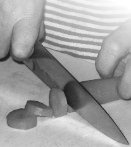Knife Skills
 Good
knife skills in the kitchen will help you to get the most out of your
chef's knife. With good knife skills not only do you greatly
reduce the possibility of injury but get great results for your
favorite recipes. It begins with how you hold the knife and
the
proper technique for holding the food. The chef's knife is
designed for a number of techniques. The curve at the front
of
the blade allows for slicing or using a rocking motion with the front
of the blade in contact with the cutting surface (see the picture to
the left).
Good
knife skills in the kitchen will help you to get the most out of your
chef's knife. With good knife skills not only do you greatly
reduce the possibility of injury but get great results for your
favorite recipes. It begins with how you hold the knife and
the
proper technique for holding the food. The chef's knife is
designed for a number of techniques. The curve at the front
of
the blade allows for slicing or using a rocking motion with the front
of the blade in contact with the cutting surface (see the picture to
the left).The Grip
To give you the highest degree of control and safety, the preferred method for holding the chef's knife is to have the last three fingers gripping the handle and the thumb and forefinger gripping the blade at the bolster (see glossary below). This grip allows your hand to be right at the balance point for most knives. It also keeps the knife from twisting from side to side, reducing the risk of injury, and gives you the best control over cutting. Done right, this way of gripping the knife allows you to feel as if the knife is an extention of your arm.
The Guiding Hand
Normally, your dominant hand will hold the knife, (the right hand if you are right handed) and the other hand will hold the food in such a way to hold it firmly, giving you precise control over the size of the cut and increasing safety. The standard skill is to curl the fingers back so that if the knife touches the fingers they will only rest against the knuckles.
Recipe Indications
The goal of using these standard sizes of cuts is for two primary reasons. First, if there is a uniform size, then cooking times should also be uniform. Second, if the cuts are uniform, then it gives the food a very appealing look. Going from small to large:
Julienne: also known as matchstick, is a cut measuring 1/8" by 1/8" by about 3 inches.
Brunois: is a very small dice measuring 1/8" cubed. Start with a julienne and rotate it 90 degrees and cut at each 1/8 of an inch.
Allumette: a cut measuring 1/4" by 1/4" and length of 2 1/2 to 3 inches.
Small Dice: a cut measuring 1/4" cubed. You start with allumette and rotate it 90 degrees and cut at each 1/4 inch.
Mire poix: a cut measuring 3/8" cubed. This also refers to the basic combination of 2 parts onions to 1 part celery and 1 part carrots diced.
Batonnet: a cut measuring 1/2" by 1/2" and about 3" in length. This would be commonly referred to as "carrot sticks."
Dice (or medium dice): a basic cut measuring 1/2" cubed. Start with batonnet and rotate it 90 degrees and cut at each 1/2 inch.
Large Dice: cut a 3/4" cube.
Bias Cut: cutting at an angle between 45 and 60 degrees. This gives a very attractive presentation of vegetables.
Bolster: the place on the knife where the blade meets the handle. This is usually the point where the knife balances. It is more pronounced on knives with forged blades.
Guiding hand: the hand holding the food and guiding it with reference to the knife.